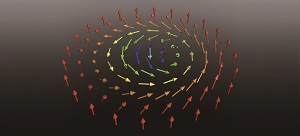Feb. 3, 2012 Research Highlight Physics / Astronomy
Manipulating the texture of magnetism
Derivation of equations that describe the dynamics of complex magnetic quasi-particles may aid the design of novel electronic devices
 Figure 1: A skyrmion is a vortex-like arrangement of spins, depicted here as arrows. Knowing how to control their motion could lead to a new class of electronic memory. © 2012 RIKEN
Figure 1: A skyrmion is a vortex-like arrangement of spins, depicted here as arrows. Knowing how to control their motion could lead to a new class of electronic memory. © 2012 RIKEN
Knowing how to control the combined magnetic properties of interacting electrons will provide the basis to develop an important tool for advancing spintronics: a technology that aims to harness these properties for computation and communication. As a crucial first step, Naoto Nagaosa from the RIKEN Advanced Science Institute, Wako, and his colleagues have derived the equations that govern the motion of these magnetic quasi-particles1.
The magnetic behavior of a material is the result of a phenomenon known as spin. This can be thought of as the rotation of electrons and is usually visualized as an arrow pointing along the rotation axis. In some crystalline solids, neighboring electron spins can interact with each other such that the arrows form vortex-like patterns (Fig. 1). This spin ‘texture’ is robust and remains intact despite outside influences; it can also move through the material crystal, even though the atoms themselves remain stationary. Because of these properties, physicists often think of such spin vortices as particles in their own right; they call them skyrmions. The work of Nagaosa, with researchers from China, the Netherlands and Korea, provides a theoretical framework that describes skyrmion dynamics.
Skyrmions, and the ability to control them, have the potential to increase the packing density of magnetic recording media; as such, skyrmion-based devices are likely to be more efficient than conventional memories. “Skyrmions can be moved with a current density as much as a million times smaller than those needed to control magnetic structures, thus far,” explains Nagaosa.
The researchers theoretically investigated skyrmion crystals—ordered arrays of many skyrmions—that are supported by thin metallic films. Nagaosa and his collaborators2 had suggested previously that skyrmion crystals are more stable in thin films than they are in thicker ‘bulk’ materials, making films more amenable to practical applications. The equations of motion derived by Nagaosa and colleagues also showed: how the electrons are influenced by skyrmions; that skyrmions can become pinned to impurities in the film; and that the skyrmion trajectory bends away from the direction of an electrical current. The researchers called this phenomenon the skyrmion Hall effect because of its similarity to the sideways force that is exerted on an electron as it moves through a conductor in a magnetic field, which was discovered by Edwin Hall in 1879.
“Next we intend to study the effect of thermal fluctuations of the skyrmion structure and the optical manipulation of skyrmions,” says Nagaosa. “These are the important issues on the road towards applications.”
References
- 1. Zang, J., Mostovoy, M., Han, J.H. & Nagaosa, N. Dynamics of skyrmion crystals in metallic thin films. Physical Review Letters 107, 136804 (2011). 10.1103/PhysRevLett.107.136804
- 2. Yi, S.D., Onoda, S., Nagaosa, N. & Han, J.H. Skyrmions and anomalous Hall effect in a Dzyaloshinskii-Moriya spiral magnet. Physical Review B 80, 054416 (2009). 10.1103/PhysRevB.80.054416
